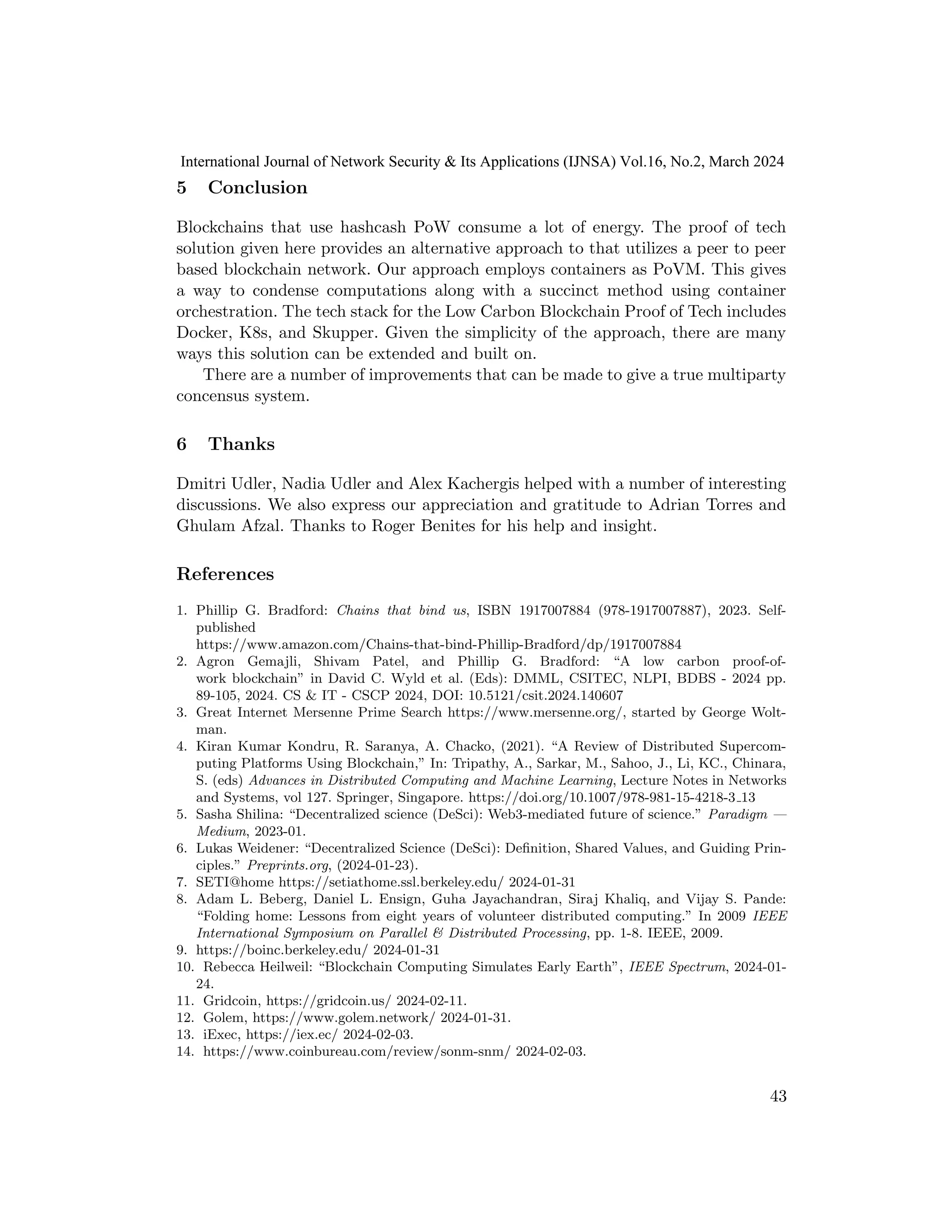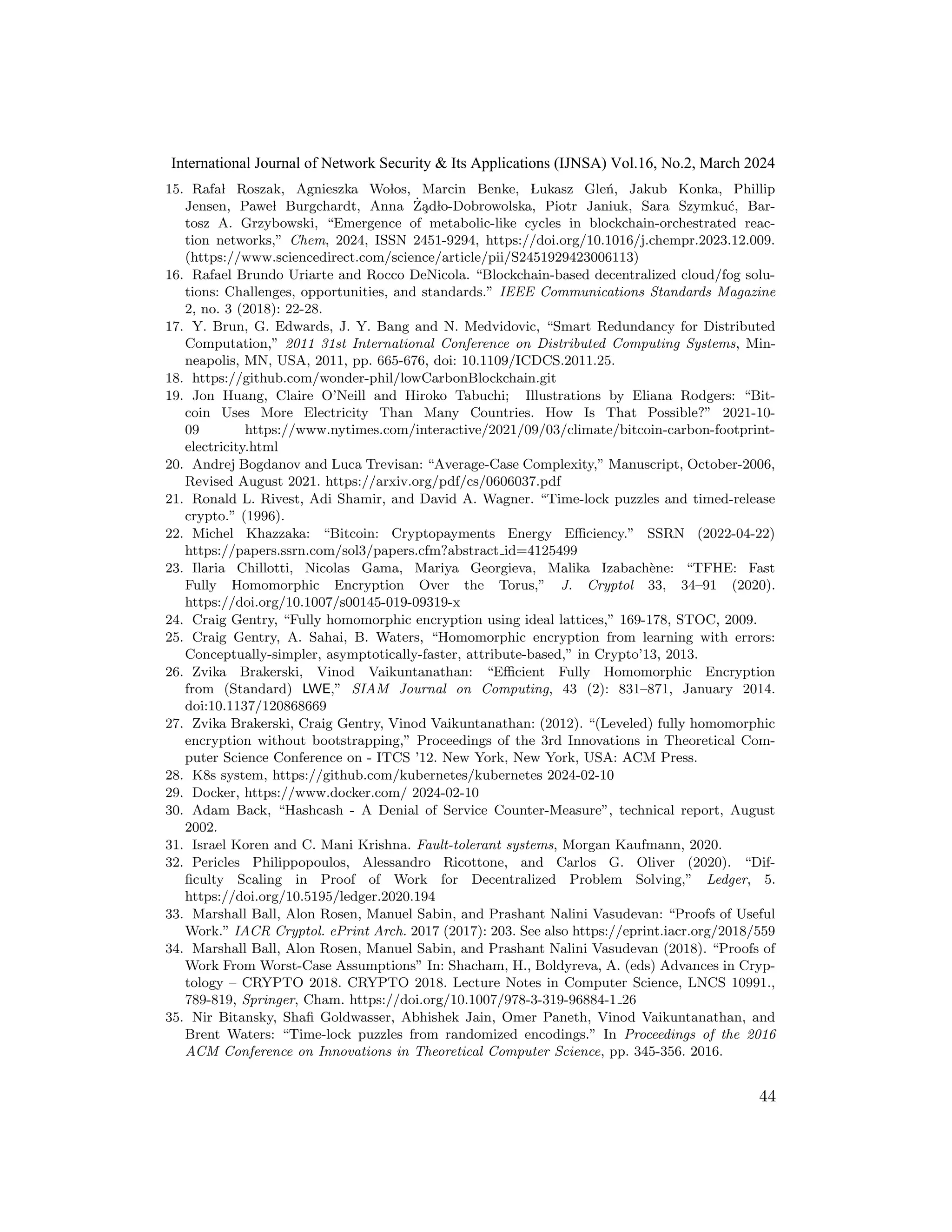The document proposes a low-carbon alternative to traditional Proof-of-Work (PoW) blockchains through a Proof-of-Virtual-Machine (PoVM) system, which utilizes virtual machines for job execution instead of energy-intensive mining. By employing a lottery system to reward operators of these virtual machines with lottery tickets proportional to their contributions, the approach aims to reduce carbon emissions typically associated with PoW blockchains. Key challenges such as configuration validation and adherence to service-level agreements are discussed, along with comparisons to existing blockchain systems.
![Towards a low carbon
proof-of-work blockchain
Agron Gemajli, Shivam Patel, and Phillip G. Bradford
School of Computing, University of Connecticut, USA
Abstract. Proof of Work (PoW) blockchains burn a lot of energy. Proof-of-work
algorithms are expensive by design and often only serve to compute blockchains. In
some sense, carbon-based and non-carbon based regional electric power is fungible.
So the total carbon and non-carbon electric power mix plays a role. Thus, gener-
ally PoW algorithms have large CO2 footprints solely for computing blockchains. A
proof of technology is described towards replacing hashcash or other PoW methods
with a lottery and proof-of-VM (PoVM) emulation. PoVM emulation is a form of
PoW where an autonomous blockchain miner gets a lottery ticket in exchange for
providing a VM (virtual Machine) for a specified period. These VMs get their jobs
from a job queue. Managing and ensuring, by concensus, that autonomous PoVMs
are properly configured and running as expected gives several gaps for a complete
practical system. These gaps are discussed. Our system is similar to a number of
other blockchain systems. We briefly survey these systems. This paper along with
our proof of technology was done as a senior design project.
Keywords: Blockchain, low carbon blockchain
1 Introduction
This proof of technology assumes some familiarity with blockchains such as can be
found in [1]. A preliminary conference version of this paper was published in [2].
Proof-of-work (PoW) blockchains construct hash chains that (1) have subchains
that seem to be intractable to counterfeit and (2) their proofs-of-work are designed
to throttle the network use and abuse while allowing select workers (miners) to get
paid. These characteristics are central for building trust for autonomous actors to
use, create, and maintain PoW blockchains.
Proof-of-work blockchains consume a lot of energy. For instance, the bitcoin
network uses as much power as small countries [19]. Consider current regional en-
ergy supply mixes and the transportable nature of blockchain mining. These energy
supply mixes and regional fungibility of electricity give way to blockchains having
large CO2 footprints.
Proof-of-stake (PoS) blockchains require their participants to put up assets as
collateral. Usually, this collateral is in cryptocurrency. These participants validate
the blocks in the blockchain. This validation is akin to building the blocks in a PoW
blockchain. A winner (who gets paid) is randomly selected from the participants
International Journal of Network Security & Its Applications (IJNSA) Vol.16, No.2, March 2024
DOI: 10.5121/ijnsa.2024.16203 29](https://image.slidesharecdn.com/16224ijnsa03-240416060603-5d6bc9ca/75/Towards-a-low-carbon-proof-of-work-blockchain-1-2048.jpg)
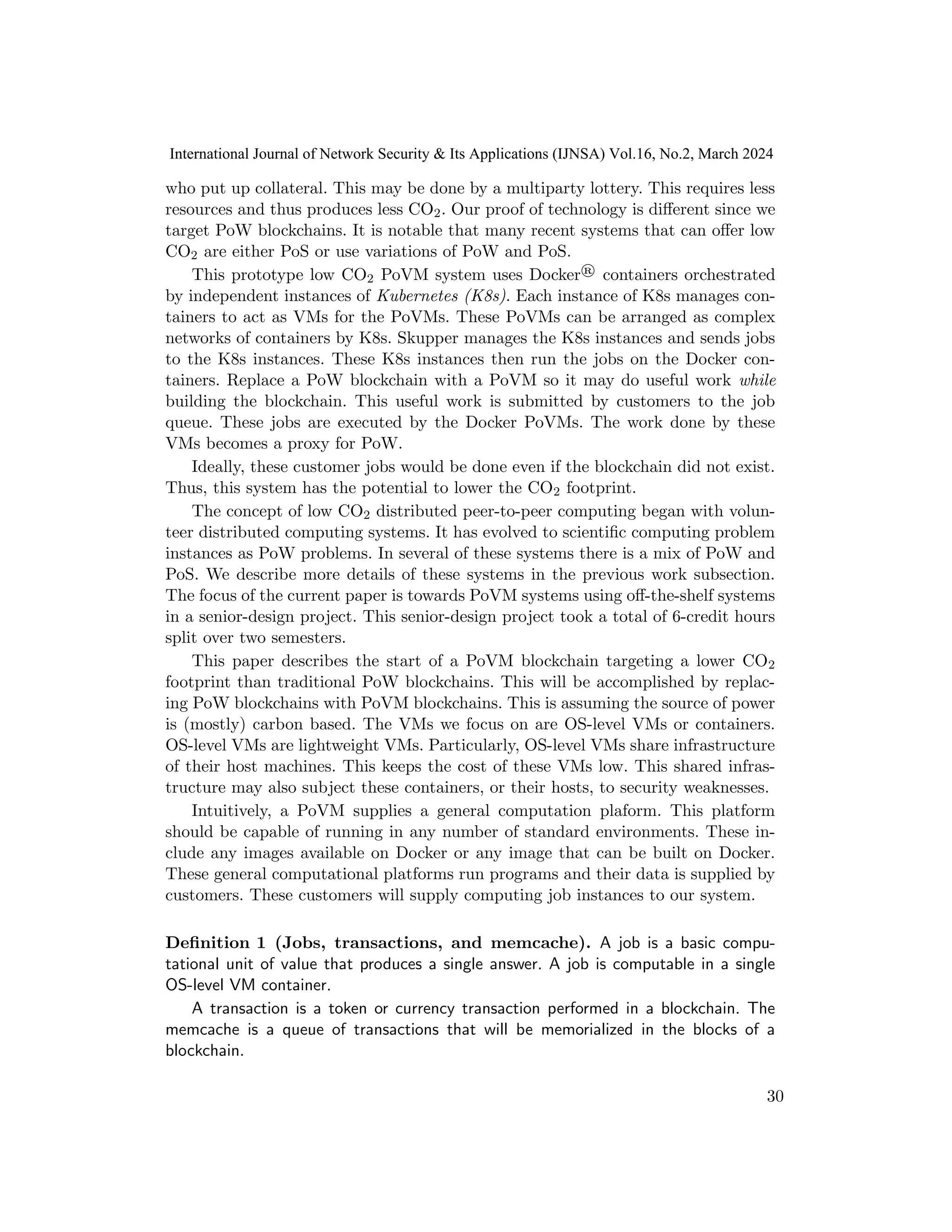
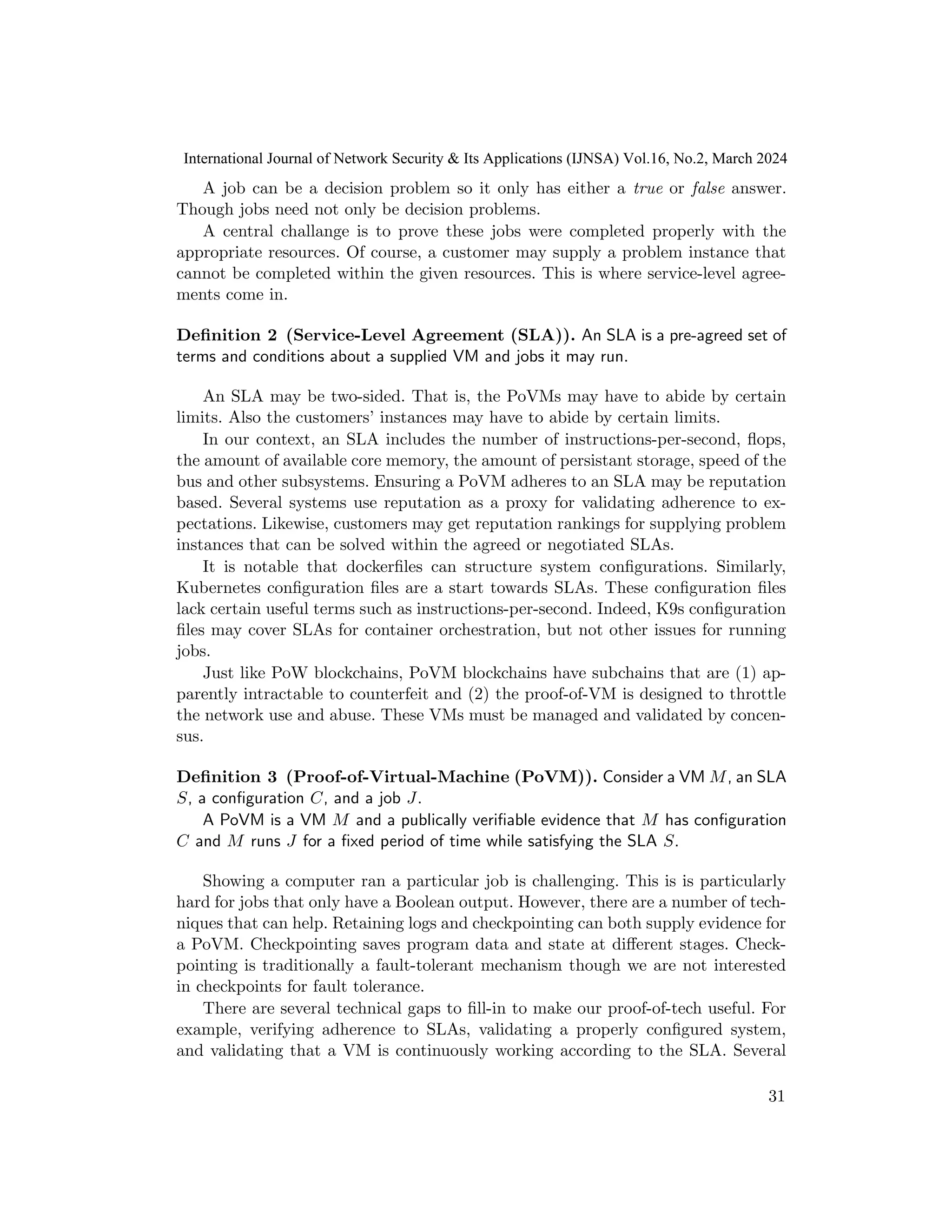
![systems, for example [12, 13], use reputation-based metrics to evaluate likelihood
of compliance going forward as well as the behavior of customers.
Smart contracts are usually computed by all miners in blockchain networks. In
other words, smart contracts are computed on-chain. Thus, on-chain PoW com-
putation generally produces a lot of CO2. The PoVMs are not on-chain, though
records of their verification are on-chain. The same holds true for the records of
the PoW calculations. That is, PoW verifications are stored in blocks but PoW
calculations are not done on-chain. PoVMs are designed to run standard loads as
PoW proxies. Neither PoW nor PoVMs are run on-chain.
It is in the egalitarian spirit of many PoW blockchains to allow anyone to
offer their mining services. So, the PoVM proposal given here can be enhanced by
homomorphic encryption. This is to prevent an organization’s competitors, or other
interested parties, from accessing their computations. Homomorphic encryption
is getting cheaper and faster [24–27, 23]. Also the proposal in this paper can be
implemented by cloud providers themselves. Indeed, several cloud providers offer
blockchains. In many cases, cloud users already trust their cloud service providers.
These users expect the cloud providers will keep their systems and data secure.
Homomorphic encryption can help here, though it must be very efficient so the
PoVMs have low CO2 consumption.
Khazzaka [22] argues that, all told, the current traditional global payments sys-
tems require more energy than Bitcoin and Bitcoin related systems. This argument
is made by an analysis of traditional payment systems. Their analysis includes
bank transfers, credit checks, running physical bank branches, software clients and
servers, ATM machines, etc. The energy costs they analyze also include creating
and distributing new notes and coins. less expensive.
1.1 Hashcash PoW
Hashcash is used for PoW blockchains. Hashcash uses message digest hash functions
to find new blocks for many PoW blockchains. The computation using these message
digest hash functions is interesting. In the case of hashcash, these computations have
no apparent application besides restricting participation in building blocks.
A message-digest hash function is a function that maps large strings to small
fingerprints. A fingerprint is a small string that may uniquely represent the large
string input. This representation is done by mapping a domain of large strings to
a range of small strings by a message-digest function. Of course, by the pigeonhole
principle, a set of all large strings cannot uniquely map to a set of all small strings.
Particularly, consider the set S of all strings of length 1,024-bits. This set cannot
be uniquely mapped to the set F of all 8-bit strings. Any such mapping must map
many strings from S to the same element of F and so on. However, ideal message-
digest hash functions, which may not exist, would have the property that if |F| is
large enough then it is very hard to find collisions of elements of S.
32
International Journal of Network Security & Its Applications (IJNSA) Vol.16, No.2, March 2024](https://image.slidesharecdn.com/16224ijnsa03-240416060603-5d6bc9ca/75/Towards-a-low-carbon-proof-of-work-blockchain-4-2048.jpg)
![Example small fingerprint may be 180-bits, 256-bits or even 512-bits. Ideally
message-digest functions should run fast, but ideally it should be intractable to
find a collision from the message-digest of two different inputs.
Suppose h is a message-digest hash function. Given a string B, it appears to
be intractable to find another string B′ so that h(B) = h(B′). This property is
collision resistance.
Consider two strings S and T. Then ST is the concatenation of S and T.
A challange that seems easier than collision resistance, is to find another string
N so that h(BN) < T. For example, say any N will do if the message-digest hash
function h outputs 180-bit fingerprints. That is, if T = 2180 − 1, then h(BN) < T
is always true. If T = 2180 − 2 is often true for many strings N, etc.
Miners do their work by modifying their own nonce N. Each miner can inde-
pendently change their nonce. The first miner credited with solving the hashcash
proof of work gets paid. Of course, without paying for support, blockchains would
not last long. So, some form of payment to the miners is important.
Definition 4 (Hashcash Proof of Work [30, 38]). Suppose h is a message-digest
hash function. Consider a publically shared block B and an individual miner-generated
nonce N. The first recognized miner to sufficiently modify their own nonce N to
generate the proscribed number of 0s in the initial part of the message-digest hash-
function of BN is declared the winner.
Consider an ideal message-digest hash function h. Computing a message-digest
hash function h on an input B is easy. That is, computing h(B) is easy. Finding
which nonces N are such that h(BN) < T for some threshold value T appears
hard, but seems much easier than finding a collision. Finding a threshold value T
so that h(BN) < T is the same as finding a certain number of 0s in the initial part
of the message-digest hash-function of BN. The smaller the threshold T the harder
it is to find a nonce N so that h(BN) < T.
Dwork and Naor [38] introduced proof-of-work. Back introduced blockchains
and indicated [30]: “Hashcash was originally proposed as a mechanism to throttle
systematic abuse of un-metered internet resource.”
Hashcash proof of work also contends with apparent ties for the first miner to
solve the Hashcash problem. If two or more miners are credited with winning a
block simultaneously, then declaring a winner is defered to the next mining round.
Each of the miners, simultaneously credited with winning, has its own subchain.
Each of these subchains is a potential winning subchain. In this next mining round,
miners work off of any potentially winning subchain. Whichever of these potentially
winning subchains is extended and validated first becomes part of the blockchain.
The other potential subchains are often abandoned.
Figure 1 shows a tiny blockchain. After the genesis block G = B0, the message
digest hash function h computes a fingerprint of the previous block concatenated
33
International Journal of Network Security & Its Applications (IJNSA) Vol.16, No.2, March 2024](https://image.slidesharecdn.com/16224ijnsa03-240416060603-5d6bc9ca/75/Towards-a-low-carbon-proof-of-work-blockchain-5-2048.jpg)
![Fig. 1. A blockchain-like hash chain
with one of the miner’s nonces. Before choosing to use a blockchain, users assume
the genesis block is the valid starting block. They also assume ideal message digest
hash functions. This assumes: it is intractable to find two distinct inputs that have
the same fingerprint. Thus, supposing an ideal message-digest hash function h and
a single input block B. Two miners can generate a different inputs BN1 and BN2
based on their own independent choices of nonce N1 and N2. It seems intractable
to find two different nonces N1 ̸= N2 so that h(BN1) = h(BN2). So, traditional
PoW blockchains leverage the Hashcash-PoW challenge of computing the same
fingerprint with different inputs (BN1 and BN2). In both cases, each miner has no
apparent advantage in finding a suitable modified input BN1 and BN2 to ensure
h(BN1) or h(BN2) are sufficiently small. Hashcash-PoW seems to depend on effort
and luck.
We propose replacing Hashcash-PoW with a lottery along with PoVM. The
winner of the lottery gets paid, in essence, for supporting the network.
The number of lottery tickets is proportional to the number of PoVMs a miner
successfully emulates. This emulation is assumed to be with the given configuration
and the given SLA. These VMs run jobs from the job queue. The cost of VM
emulation will throttle miners from abusing the PoVM system. The blocks contain
transactions from the mempool. These blocks are joined by message digest hash
functions, but without doing Hashcash-PoW computations.
In the start of this proof of technology, we use Docker, Kubernetes (K8s), and
Skupper. K8s manages and monitors container loads. It also uses heartbeats to
monitor containers. Skupper connects K8s instances. We have not implemented the
configurations or any SLAs.
1.2 Previous work
Voluntarily sharing idle computer time has been around since at least the mid
1990s [3]. See a few other early volunteer systems in [8, 37]. Later prominent ex-
amples include [7–9]. Voluntary computing systems based on the blockchain were
proposed in Shan [45]. Shan focuses on using blockchains to avoid a single-point
of failure found in centeralized systems. In addition, Shan points out the peer-to-
peer nature of blockchains can enhance auditing of volunteer computing. Adding
34
International Journal of Network Security & Its Applications (IJNSA) Vol.16, No.2, March 2024](https://image.slidesharecdn.com/16224ijnsa03-240416060603-5d6bc9ca/75/Towards-a-low-carbon-proof-of-work-blockchain-6-2048.jpg)
![blockchains to solve computational portions of science problems as proxys for proof-
of-work gave way to Decentralized Science (DeSci) [5, 6]. Indeed, the DeSci prob-
lem instances are the proofs-of-work. The cryptocurrency generated can also help
sustain volunteer networks for computing DeSci challanges. DeSci offers the poten-
tial for verification/reproducibility, trust, intellectual property tracking, funding,
among other advantages [5, 6]. Of course, these science problem instances as PoW
proxies lower the overall CO2 produced. There are several blockchain systems that
serve processing power, as proofs-of-work, for general computation [4, 16]. Such real-
world systems include Golem [12], Gridcoin [11], iExec [13], and SONM [14]. These
blockchains are a mix between PoW and PoS. Gridcoin is focused on computation
for science and builds on [9, 8]. It is notable that Golem has recently performed
substantial chemical calculations simulating the beginnings of life, see Roszak, et
al. [15] and also the report in [10]. Golem depends on its compute suppliers to run
KVM on their machines.
Ghaemi, Khazaei, and Musilek [37] give a serverless blockchain compute plat-
form using idle computer capacity. They use Hyperledger Fabric and a concensus
system rather than PoW or PoS.
Ball, Rosen, Sabin, and Vasudevan [34] suggest worst-case problem instances
as proof-of-work problems. There are practical problems that have been expressed
as instances of SAT. The Satisfiability Problem (SAT) is a classical NP-complete
problem The SAT appears hard in the worst-case. Although, it is not known how
challenging solving SAT instances is on average [20]. Ball, et al. [34] highlight the
assumption that the Hashcash PoW seems to provide good proofs-of-work. However,
they mention they are not aware that the Hashcash PoW problem captures any
complexity class. So breaking Hashcash PoW problem may only break Bitcoin and
other similar systems, rather than providing a complexity theory breakthrough.
Their work is based on their earlier work: Ball, Rosen, Sabin, Vasudevan [33]. This
earlier work is to solve certain graph problems that can be expressed in first order
logic.
Other prior work includes, time-lock puzzles as proofs-of-work by Bitansky,
Goldwasser, Jain, Paneth, Vaikuntanathan, and Waters[35]; Time-lock puzzles may
help with certain types of SLAs.
Philippopoulos, Ricottone, and Oliver [32] and Oliver, Ricottone, and Philip-
popoulos [41] focus on NP-complete problem instances. Loe and Quaglia [40] also
propose using NP-complete problem instances as proofs-of-work. Particularly, they
offer a type of traveling salesperson problem. They also give a table of alternatives
to Hashcash for proof-of-work.
Chatterjee, Goharshady, and Pourdamghani [36] propose encoding submitted
problems as SAT (Boolean Satisifiability Instances). Their model proposes that
miners can select the traditional Hashcash PoW or a submitted NP-complete
problem instance of the SAT problem. They discusses how many ‘useful prob-
35
International Journal of Network Security & Its Applications (IJNSA) Vol.16, No.2, March 2024](https://image.slidesharecdn.com/16224ijnsa03-240416060603-5d6bc9ca/75/Towards-a-low-carbon-proof-of-work-blockchain-7-2048.jpg)
![lem instances’ papers or applications may not, in fact, be useful in the immediate
term. They indicate, of course accumulating knowledge about problem solutions,
even if not immediately applicable, may be useful. However, they propose industri-
ally necessary NP-complete problems that are useful in the “immediate practical
value.”
1.3 Technologies used
Our proposal focuses on off-the-shelf technologies. Some of the distributed comput-
ing systems such as Gridcoin, Golem and iExec leverage several of these technologies
as well [11–13].
Docker Docker [29] is the basis of Docker.com and Docker is open source. It is the
most popular system for managing and executing virual containers. Containers are
OS-level virtual machines. That is, each container shares some of the underlying
operating system’s infrastructure. This makes the containers more lightweight than
full virtual machines. At the same time, containers are not independent from their
underying systems. Namespaces isolate containers from their hosts [43].
Figure 2 shows the general structure of Docker containers. Particularly, the
plethora of images docker users maintain allows very general computational prob-
lems to be executed. These images and their standard installations can be used as
the configuration set ups needed for general PoVM computation. Particularly, a
dockerfiles can be a specific configuration. Dockerfiles form the Docker repository
can be validated using hash functions.
Fig. 2. Basic containers
36
International Journal of Network Security & Its Applications (IJNSA) Vol.16, No.2, March 2024](https://image.slidesharecdn.com/16224ijnsa03-240416060603-5d6bc9ca/75/Towards-a-low-carbon-proof-of-work-blockchain-8-2048.jpg)
![Kubernetes Kubernetes (K8s) [28] is a Cloud Native Computing Foundation open
source project. K8s manages or orchestrates containerized services and workloads.
It provides a framework for running distributed systems resiliently. K8s has many
features including: Service discovery, load balancing, load management, automatic
rollouts and rollbacks, self-healing, and configuration management. When working
with containers, K8s works with container technologies such as Docker or LXC.
Docker is the most used technology with K8s.
Kubernetes resource files are a good start towards orchestration SLAs. These
resource files describe how K8s should balance loads, structure docker instances, and
scale. Another type of SLA contract or file may be best for enforcing instructions-
per-second, flops, etc.
Skupper Skupper [44], is an Apache Software Foundation open-source system. It
creates a virtual application network (VAN) for multiple instances of K8s [44]. As
shown in Figure 3, Skupper connects multiple K8s instances using virtual applica-
tion routers. Each K8s instance contains its own networks and containers. Skupper
works via K8s namespaces which separate services within a cluster and allows for
managed instances of K8s.
Skupper is not a multiparty concensus based system. So, it does not fit the
general requirements for a blockchain-like system. Furthermore, Skupper’s work is
not documented in a blockchain by PoW systems.
Fig. 3. Skupper architecture showing Virtual Application Routers (VANs)
2 System structure
Golem, Gridcoin, iExec and SONM all use a number of methods to ensure the va-
lidity of their outsourced and off-chain computation [12, 11, 13, 14]. A key method
these systems use for validation of outsourced and off-chain job computation is re-
dundantly computing jobs. Then they compare the outcomes of these computations.
37
International Journal of Network Security & Its Applications (IJNSA) Vol.16, No.2, March 2024](https://image.slidesharecdn.com/16224ijnsa03-240416060603-5d6bc9ca/75/Towards-a-low-carbon-proof-of-work-blockchain-9-2048.jpg)
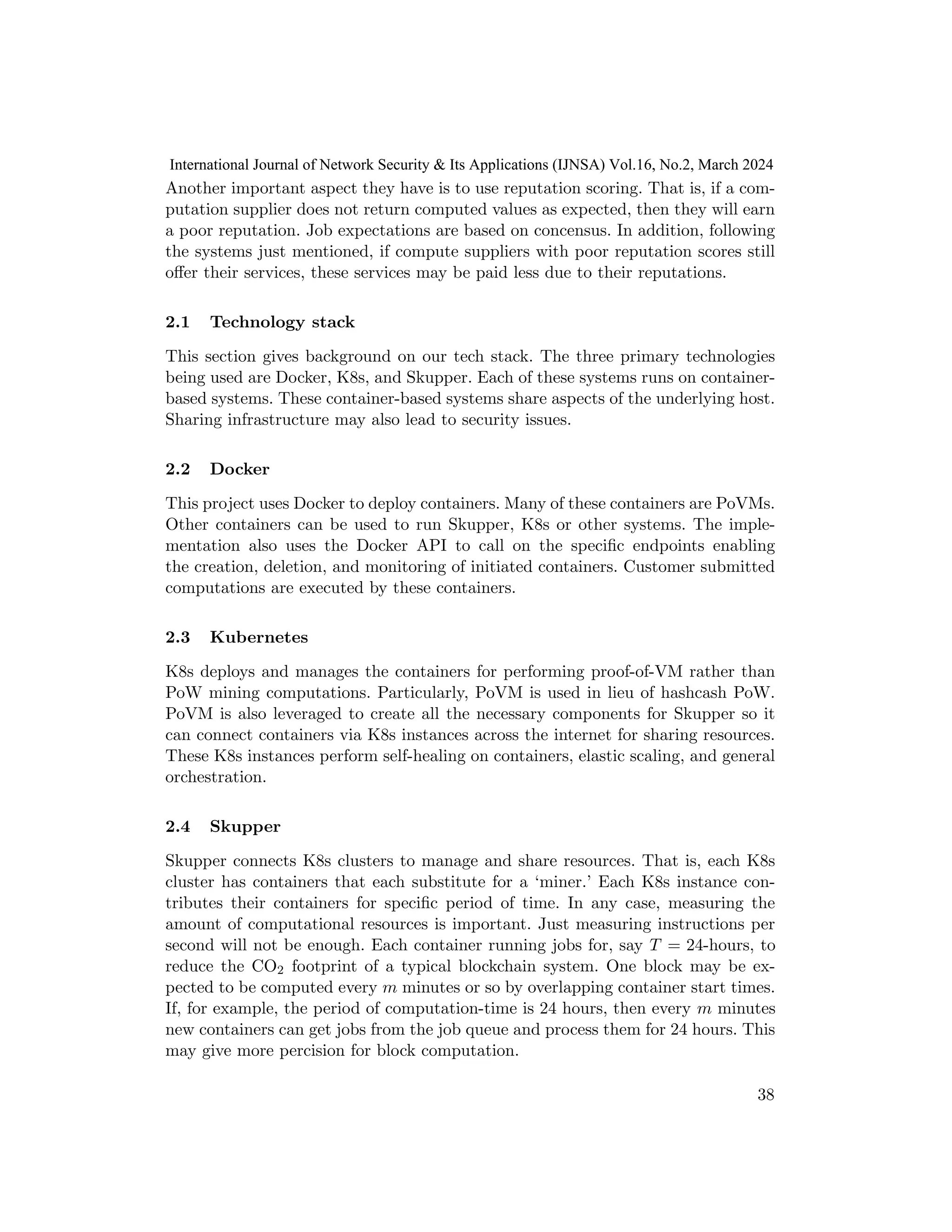
![We must ensure each job is correctly computed. That is, there is no accidental
or purposeful deception in any of the computation.
For example, some jobs can be computed by independent containers from dif-
ferent K8s clusters. Their solutions can be compared to validate the correctness
or incorrectness of the calculations. This was implemented in Golem [12] among
other systems. This can be easily modeled using probability theory. Then trade-
offs can be made with the total cost and CO2 footprints as compared to repeated
calculations.
2.5 Technical gaps
Our proof of technology does not include certain technical features that make it
conform to be a single blockchain system.
1. We have not implemented a multiparty concensus-based lottery using multi-
party generated randomness. This can be done using smart contracts.
2. We do not have a multiparty concensus-based job queue. This can be done using
smart contracts.
3. We do not have a solution for running Skupper by multiparty concensus. This
may require a large amount of work. It seems to be quite challenging to adapt
Skupper to be run as a multiparty concensus system.
4. Kubernetes is not run by multiparty concensus. It seems it would be very chal-
lenging and unwise to adapt K8s to be run as a multiparty concensus system
nor does K8s seem amenable to such modifications.
5. PoVM - multiparty concensus-based validation of job computation. The valida-
tions will require work with formalizing and validating configurations and SLAs
using multiparty concensus.
3 Implementation
This section gives more details about our solution. It starts with a basic setup of
the technologies. Next, it goes into a detailed discussion of how our system works.
We have a basic proof of technology demonstration that can be run.
3.1 Our Solution
Docker, K8s, and Skupper are set up so customers submit jobs to peer distributed
network though a webpage. These jobs are put on the job queue. Currently the
job queue is not managed by multiparty PoW concensus. However, it is possible to
have a smart contract manage the job queue.
Transactions for blockchain processing can be put in a mempool as in standard
blockchains. Each host supplies its own instance of a K8s cluster consisting of
39
International Journal of Network Security & Its Applications (IJNSA) Vol.16, No.2, March 2024](https://image.slidesharecdn.com/16224ijnsa03-240416060603-5d6bc9ca/75/Towards-a-low-carbon-proof-of-work-blockchain-11-2048.jpg)

![3. Once submitted, the frontend server local to the host queries the Skupper net-
work and pick another online host’s K8s namespace at random and send the
packaged data to a specifically targeted port.
4. The receiving host’s frontend listener picks up the packaged data and calls the
internal backend listener to spawn a container that will flip the coins.
5. The container computes the total number of flips needed to get k heads.
6. The container packages the answer and returns it to the backend listener which
then talks to the original host through Skupper and provides the result.
7. The initial host opens the packaged response and updates the site to reflect the
result from the request.
3.2 Running the demo
The prerequisites for showing our proof of technology are given here. We use Mac
OS X to run Docker desktop and Skupper. The following software needs to be
installed prior to following this quick start guide:
– Docker (w/Docker Desktop)
– Kind (K8s local cluster manager for Docker nodes)
– If on a Mac, then use Docker-mac-net-connect (via Homebrew)
We use kind for local management of our K8s instances. The choice of local
management of K8s was to make this demonstration easy and inexpensive to run.
Once all the pre-requisites have been installed, clone the following project repos-
itory into a folder of your choice from the repo [18].
After cloning the repository, the majority of the instructions should be on the
documentation provided, however, for the sake of simplicity, the following sub-
points help with the demo.
1. Create the KIND cluster
2. Create K8s configuration files
3. Set-Up the Metal Load Balancer
4. Connect all local namespaces via Skupper
5. Apply all K8s configurations for each namespace
6. Create all K8s deployments and expose the relative ports
7. Test the technology.
Now a basic Skupper network consisting of a head-sequence flipper example is
available. The only required piece needed is to connect to the internal IP of the
frontend docker container. Once the page loads, entering a number for the input
causes the system to flow and prompt a response from a container run in another
namespace.
41
International Journal of Network Security & Its Applications (IJNSA) Vol.16, No.2, March 2024](https://image.slidesharecdn.com/16224ijnsa03-240416060603-5d6bc9ca/75/Towards-a-low-carbon-proof-of-work-blockchain-13-2048.jpg)
![4 Future directions
Performing percise CO2 analysis. Adding a multi-signature scheme such as a Schnorr
signature [39] where needed.
Exploring an iterative redundancy algorithm due to Brun, Edwards, Bang, and
Medvidovic [17]. See also [31]. It is notable that Brun, et al. [17] discuss testing
with the volunteer science system BOINC [9]. Brun, et al. show how to compare
the results of several PoVMs performing the same computation. These redundant
calculations help prevent fraudulent computation. For instance a VM that either
accidentally or purposely does not do the correct computation. These redundant
calculations have been implemented in many systems such as Golem [12].
Given a single job j to compute, k-vote traditional redundancy (TR), where k
is an odd integer, is
1. Clone job j onto k different but identical machine instances
2. Run one job j on each of k identical but independent containers
3. Assume all job outputs are Boolean. All jobs outputs are compared and the
majority of votes wins.
Since k is odd, it is pointed out that at least, k+1
2 of the same answer is evidence
of a valid computation. Our objective is to ensure that k is far smaller than the
number of expected PoW nodes.
Let T be the total time for computing each clone for one PoVM job. In the
worst-case we compute all k jobs. For comparison, the PoW costs p and there are
w total miners computing each of these hashcash functions. Thus, τ compares the
basic cost of PoVM.
τ = (kT + c) − pw
We can also leverage checkpointing to enhance validation of evidence for PoVMs.
The checkpoints can be computed on all cloned jobs that are redundantly computing
the same work for validation. In our case, checkpoints or their sub-checkpoints can
be computed at the same program events for all clones. We can compare clone
checkpoints to validate different jobs are doing the expected computation. These
checkpoints may be kept secret by message-digesting them for each clone. These
comparisons be done using message-digest hash functions. There are challanges to
this approach. For example, in asynchronous or randomized algorithms, different
intermediate states may differ on different machines, yet these systems may compute
the same final result. Such cases require careful assessment of the checkpointing.
All of our technical gaps are of interest in the future. That is, making the entire
system run using multiparty concensus. Perhaps the hardest part here is replacing
Skupper.
42
International Journal of Network Security & Its Applications (IJNSA) Vol.16, No.2, March 2024](https://image.slidesharecdn.com/16224ijnsa03-240416060603-5d6bc9ca/75/Towards-a-low-carbon-proof-of-work-blockchain-14-2048.jpg)
